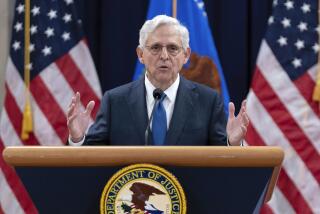B of A Posts Loss; Fined $4.7 Million : Penalty for Unreported Cash Deals Comes on Top of $337-Million Deficit
- Share via
BankAmerica Corp., suffering twin blows Tuesday, was fined a record $4.75 million for violating federal cash-transaction reporting laws and announced a stunning $337-million loss for 1985, the bank’s first annual loss since the Depression year of 1932.
The bank also suspended dividend payments on its common stock, affecting 148,000 individual shareholders. BankAmerica had paid common share dividends continuously for 52 years.
The bad news capped a dismal 1985 for San Francisco-based BankAmerica, parent company of Bank of America, the nation’s largest bank. Although a fine and a substantial loss for the year had been expected, the magnitude of each was startling.
Third-Largest in History
The bank’s $337-million loss is the third-largest annual deficit in U.S. banking history, ranking behind Continental Illinois’ $1.1-billion loss in 1984 and Seafirst’s 1983 loss of $456 million. BankAmerica, which also reported a fourth-quarter loss of $178 million, suffered massive losses last year in loans to farmers, real estate developers, consumers, shipping firms and Third World nations.
The bank’s board of directors Tuesday voted unanimously to eliminate the dividend, which has been 20 cents a share since last August, when it was reduced from 38 cents. Dividends on preferred shares were not affected.
“Without question, 1985 was a year of wrenching change for the corporation,” Samuel H. Armacost, president and chief executive, said in a statement. “As has been the case throughout the year, high loan losses continued to overshadow the progress we’ve been making in other areas.”
In announcing the fine under terms of the Bank Secrecy Act, the Treasury Department said Bank of America committed more than 17,000 violations of the 1970 law, which is a tool used to combat the laundering of cash proceeds from drug smuggling, gambling and other illegal activities. The law requires financial institutions to report most cash dealings of more than $10,000 to the Internal Revenue Service.
No Masked Wrongdoing
Treasury officials said they had no evidence that Bank of America’s unreported transactions masked any wrongdoing.
The fine was the largest civil penalty ever assessed under the secrecy law, eclipsing the $2.25 million levied against Crocker National Bank of San Francisco last August for failure to report 7,877 transactions. However, the fine against Crocker represented a higher percentage of its $22 billion in assets than the Bank of America levy.
BankAmerica has total assets of $119 billion.
“The violations by Bank of America were widespread throughout the units and branch system of the bank,” said Francis A. Keating II, assistant secretary of the Treasury for enforcement and operations.
“While Treasury has no information that the bank engaged in criminal activity in connection with these violations, it is certain, given the volume and nature of violations, that the non-filing of information about cash transactions deprived the government of timely law enforcement leads in drug, tax and other investigations.”
Bank of America has 935 branches in California and a broad network of offices around the globe. George Coombe, the bank’s general counsel, said the violations were not concentrated in any one geographic area and could not be traced to any pattern of illicit activity.
Coombe said many of the Bank of America violations involved bank customers who were improperly granted exemptions from the reporting law. Under the regulations, companies that regularly handle large cash sums--for example, supermarkets, race tracks, theaters--do not have to report their deposits. But Bank of America granted such exemptions to a used-car auction house and a ski resort, Coombe said, and both were disallowed by the Treasury.
“Some of these calls were quite close. And if you guess wrong, each transaction instantly becomes a violation. But I can state unequivocally there was no sign of any illegal activity” behind the unreported transactions, Coombe said.
He added that a number of bank employees had been disciplined for negligence and failure to follow established procedures. He said bank rules for reporting cash transactions have been tightened in the last year and that the bank will not challenge the fine.
Crackdown Pursued
Since early last year, the Treasury, under pressure from Congress, has been pursuing a crackdown on banks not complying with the law. Bank of America was the 11th bank to be fined.
Treasury officials said extensive violations of the reporting law were uncovered by auditors from the Office of the Comptroller of the Currency. The office, which regulates national banks, conducted an exhaustive examination of Bank of America in the spring and summer of 1985.
The comptroller’s office also played a pivotal role in the bank’s decision to aggressively write off bad loans in its $82-billion loan portfolio and to eliminate the common stock dividend.
Regulators said last year, in a statement pointed directly at Bank of America, that financial institutions should not pay dividends unless they are earned in profits. It also took a hard line in forcing banks to admit that a greater share of their non-performing loans were complete losses.
Conservative Approach
Until last spring’s examination, Bank of America had moved relatively conservatively to write off troubled loans. But in 1985, the bank acknowledged $1.6 billion in loan losses, a huge number, and set aside another $1.58 billion as a provision for future loan losses.
The policy represents the bank’s attempt to put the bulk of its problems behind it to clear the decks for a more normal 1986.
“We’re putting ‘paid’ to 1985 in our minds,” Armacost said Tuesday in a telephone interview. “We’ve said all along--and I know the market and the public finds it frustrating, but--you have to work your way through portfolio problems. There’s no way you can wave a wand and make them go away. We just have to get the bad assets out of here.”
The bank’s problem loans circle the globe, from San Joaquin Valley farmers to Mexican breweries to small African banks. Its consumer loan losses are running at record levels and even some of its loans to other financial institutions are going sour. Bankrupt real estate projects in California, Texas and Florida and governments throughout Latin America are also among Bank of America’s non-paying customers.
Banking industry analysts reacted with skepticism to the figures released Tuesday.
Big Question
“The big question is how thoroughly the company has cleaned the closets in 1985. . . . This isn’t the first time we felt we were at the bottom of the barrel,” said Don Crowley of the San Francisco investment firm of Keefe, Bruyette & Woods.
However, analysts and bank officials said, large though the reported loss is, it would not put the company’s solvency at risk in the way that Continental Illinois’ problems required a $4.5-billion federal bail-out. They stressed that depositors’ funds are not in jeopardy.
The good news in the bank’s 1985 financial statements was a modest decline in the overall level of non-performing loans, to $3.42 billion from $3.5 billion at the end of 1984. The resumption of interest payments on $212 million in loans to Argentina accounted for the bulk of the reduction, however.
Tuesday’s double whammy marked the end of an eventful year for Bank of America, one that bank executives said they hope never to see the likes of again.
The year began with a $95-million write-off for a mortgage securities swindle. It also saw the departure of a number of senior executives and the resignation from the board of directors of Claire Giannini Hoffman, daughter of the bank’s founder, A. P. Giannini. She left with a bitter broadside against the “insincerity and insensitivity” of current management.
Tenant in Own Building
The bank sold its elegant San Francisco headquarters and is now a tenant in its own building. It also disposed of its $3-billion FinanceAmerica unit and dozens of smaller subsidiaries and is seeking a buyer for its Los Angeles headquarters.
It was assessed $10 million in punitive damages in a court case involving a Los Angeles diamond dealer and lost $10 million more on its travelers check operation in Indonesia.
The bank also was hit by a multimillion-dollar credit card fraud involving its own employees, several shareholder lawsuits and the cancellation of liability insurance policies for its officers and directors. The company had to set up a captive insurance arm to sell it liability coverage for its employees.
Armacost said Tuesday: “1985 was a year of convergent factors. We’ve taken a lot of pain and we’re ready to get on to 1986 in a positive mood.” BANKAMERICA CLOSES A DISMAL YEAR
BankAmerica on Tuesday reported that it lost $337 million in 1985, its first annual loss since 1932 and the third largest yearly deficit in U.S. banking history. Last year the bank wrote off $1.6 billion in bad loans, chiefly in agriculture, real estate, shipping, energy and the Third World. The huge losses came despite the sale of its headquarters, its FinanceAmerica unit and dozens of smaller holdings. In addition, the bank on Tuesday was fined $4.75 million for 17,000 violations of a federal law requiring it to report large cash transactions, the largest such fine ever levied.
LARGEST PENALTIES FOR BANK SECRECY ACT VIOLATIONS Levied against institutions for failure to disclose cash transactions of more than $10,000. 1 Bank of America $4.75 million 2 Crocker National Bank $2.25 million 3 Seafirst Bank $697,000 4 Bank of Boston $500,000 5 Manufactures Hanover $320,000
More to Read
Inside the business of entertainment
The Wide Shot brings you news, analysis and insights on everything from streaming wars to production — and what it all means for the future.
You may occasionally receive promotional content from the Los Angeles Times.










